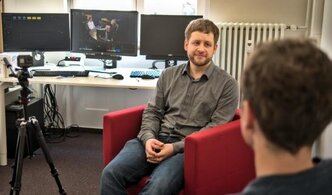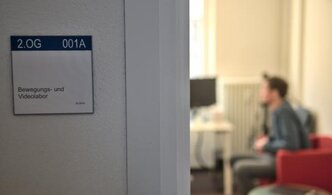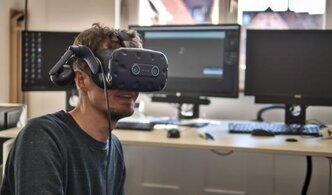Interaction lab
The interaction lab of the Department of Psychosomatic Medicine and Psychotherapy at Burgunder Str. 5a is where we study interpersonal interaction through movement patterns. The laboratory is equipped with state-of-the-art technology to produce high-quality multi-perspective video recordings. The equipment is selected and deployed in such a way that it does not become the focus of attention while the studies are being conducted. The equipment includes several small cameras, which support resolutions up to 5.3K. A powerful workstation allows efficient post-processing of the video recordings and complex data analysis. Four permanently installed LED panels on the walls of the lab provide uniform and versatile lighting conditions. The equipment of this laboratory also includes a video goggle (Head Mounted Display), which allows the display of and interaction within "virtual worlds" (Virtual Reality). We are also equipped with amplifiers and sensors for measuring physiological parameters such as heart rate, skin conductance and respiratory rate.
One research focus of the laboratory is the recording and evaluation of movement coordination or synchrony of several interactants. Especially in the psychotherapeutic field, correlations with therapeutic relationship and success variables have been demonstrated. Since limited attention has been paid to the nonverbal aspects of communication in the past, this field offers extensive research opportunities. These include methodological aspects, such as the development of new procedures for a more specific recording and evaluation of synchrony, as well as differential aspects, such as research on specific target groups, situations, and external circumstances. In a recent review we provide an overview of empirical results, and methodological issues in synchrony research in the context of psychotherapy (Scheidt et al., 2021).
So far, the following projects have been carried out at the Interaction Lab:
- Induction of synchronous movements and evaluation of the effect on relationship quality.
- Hoffmann, C. (2020). Moving together! Exploring the Influence of a Behavioral Synchrony Intervention on Quality of Relationship and Subsequent Movement Synchrony [Master Thesis]. Albert-Ludwigs-Universität Freiburg.
- Ballati, A. (2020). Interpersonal Synchrony as the embodiment of rapport: A randomized controlled trial [Thesis]. University of Padua.
- Evaluation of the differences of synchrony between direct communication and communication via video conferencing systems.
- Jahn, C. E. (2021). A Comparison of Behavioral Synchrony in Face-to-Face and Videoconferencing Conversations and the Implications for Psychotherapy [Master thesis]. Albert-Ludwigs-Universität Freiburg.
- Ahn, J.. Eine Multilevel Mixed Methods Untersuchung zur nonverbalen Interaktion und zum Schweigen in der videobasierten psychodynamischen Psychotherapie. Ongoing study.
- Evaluation of synchrony comparing problem-focused and solution-focused conversations
- Gürtler, M. (2022). Bewegungssynchronie in problem- und lösungsorientierten Gesprächen [Master Thesis]. Albert-Ludwigs-Universität Freiburg.
- Virtual Reality based modulation of the embodied self in the context of mindfulness meditation
- Hein, N. (2021). Effekte von Meditation auf verkörpertes Selbsterleben [Master Thesis]. Albert-Ludwigs-Universität Freiburg.
- Röhr, P. (2022). Effekte einer Achtsamkeitsinduktion auf multisensorische Beeinflussung des verkörperten Selbsterlebens [Master Thesis]. Albert-Ludwigs-Universität Freiburg.
Besides a general synchrony measure, interaction patterns are also evaluated for initiative ("leading") and reactive movements ("pacing").
Extracting synchrony from video recordings requires a multi-step workflow. In our lab, this includes the use of Blackmagic DaVinci Resolve video editing software, Motion Energy Analysis software (Ramseyer, psync.ch/mea), the Matlab package MEA (Altmann), the R package rMEA (Kleinbub), and the Matlab package sync_ident (Altmann,). For future work, the use of modern frameworks based on neural networks, especially in the area of computer vision and human pose estimation, such as OpenPose (Cao et al.,) and VideoPose3D (Facebook), will be explored.
Scripts, manuals and other documents to support the computation of synchrony are accessible via a GitHub repository.





